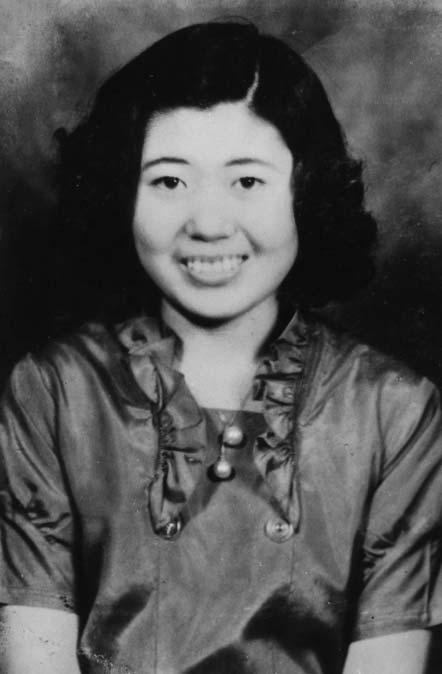
20 minute read
World War II Through the Words and Camera Lens of One Utahn
World War II Through the Words and Camera Lens of One Utahn
By J. L. CRAWFORD
I was born the same year the First World War began and was old enough when it ended to remember soldiers coming home. Two men from my hometown of Springdale served overseas, Heber Langston and Elmer Winder. Heber Langston was the only one to be killed in action. I remember his mother, Zelpha Langston, crying and saying that the war killed her boy. Forty-eight men from Springdale served in World War II and the only casualty was Vance Justet, grandson of Zelpha Langston.Vance was killed on the island of Luzon.That was supposed to be the war to end all wars, but nobody believed it. Many people said to me as I was growing up, “You will be just the right age for the next one.”And I was.

Lieutenant J.L. Crawford in combat uniform returning from the fighting on the Gustav Line in Italy.
ALL PHOTOGRAPHS COURTESY OF THE AUTHOR
I got my draft notice in January 1941, but I asked for, and was granted an extension until the end of spring quarter at Brigham Young University at which time I reported to the draft board. I was home about a month before I got my call.
Chief Ranger Donal Jolley hired me as a flagman on a road washout in Zion Canyon, with the intention of making me a seasonal ranger, until he learned Uncle Sam had other plans for me. The flagman job lasted only two weeks. My cousin, Vernon Ruesch, was being drafted at the same time and since the USA wasn’t yet into the war, the plan was to serve for a year. While we waited for our call we frequented the Canyon Inn, which was owned by our good friend Austen Excell. He had a jukebox with the song “Goodbye Dear, I’ll Be Back in a Year,” which our friends dedicated to us. Every time either of us showed up at the Inn, someone would plug in a nickel and play "our tune."

An orphan in North Africa in an army uniform provided by American soldiers.

The ancient village of Venafro located at the foot of Monte Croce and not far from the front line in southern Italy.
When we reported to the draft board in St. George, we were given the key to the city. As I recall that included a hotel room for a night, McMullin joined us as we got on the bus. In Cedar City we picked up Max Dalley and Christian Ronnow. Next stop Fort Douglas.
After induction into the Army of the United States at Fort Douglas, I went by train to Camp Wolters, Texas, where I completed basic training in October 1941, non-commissioned officers school in early 1942, and then went to Fort Benning, Georgia, where I completed officer candidate school, was commissioned a Second Lieutenant, and assigned to the 83rd Division at Camp Atterbury, Indiana. After maneuvers in Tennessee, more than one hundred officers were separated from the Division and sent overseas as replacements. In late September 1943, I left from Newport News, Virginia, on board the Empress of Scotland for Casablanca, French Morocco, in North Africa. After several weeks in North Africa, we sailed for Italy.We docked at Naples in the morning hours and were made very much aware that the war had been there ahead of us.

J. L. Crawford in his foxhole near Anzio, Italy.
I walked across the side of an overturned ship as I left our ship, then from the wreck I stepped onto a front street of Naples. I managed to snap a picture of a hotel or apartment building from which the front wall was missing, exposing bathroom fixtures on about eight floors. We were pestered by young boys wanting to carry our baggage, but I didn’t let go of any of mine since I didn’t trust the bambinos. We were loaded onto trucks and transported a few miles to the Bagnoli Race Track, which was our replacement depot. As many as ten thousand soldiers were said to be there at times, coming and going to the front or returning from it.
It was easier for the local people to get into camp than it was for soldiers to get out. I don’t know how the people got in, but there was always a line of hungry urchins near the garbage cans, with rusty cans or pans, begging for the food left on our mess gear. It didn’t matter what it was, they would go off eating it with their fingers.That saddened me more than anything I had seen in North Africa. Many times I would have donated my meal, but that wasn’t allowed.
While awaiting assignment to a fighting unit, I attended LDS services, which were held at the Victor Emmanuel School, and there I met Chaplain Eldin Ricks and Major Albert Huber. Major Huber commanded the 158th Artillery, which supported the regiment I later joined. I also ran into my old friend Max Webb, who, because of his language skills with German and Spanish, was assigned to Intelligence. He was housed in a hotel with all services provided. It seemed he wasn’t happy with his assignment and wanted to get to the front lines and have some real war experiences. He worried as to what he would tell his grandkids if he didn’t help win the war. I tried to convince him he was doing a more important job there than he could do in combat, and if he really wanted grandkids he had better stay off the front lines. He didn’t listen to me. I heard about eight months later that his jeep hit a teller mine, killing him along with his driver and a captain. I will always cherish my visits to Pompeii and Rome with him.
On Christmas Eve I attended a Catholic Mass, which seemed to be for the benefit of a few hundred of us who were on our way to the fighting front. A day or two later I was on a truck traveling on muddy roads towards the Volturno River Valley where I was dumped. I ate my 1944 New Year’s dinner out of a mess kit in a pup tent in a snowstorm in an olive orchard near the Italian town of Venafro. Here I was assigned platoon leader of third platoon, Company B, 157th Infantry, 45th Division.

During free time in Rome, Crawford and his friend George Bolz, shown in this photograph, tour Rome and surrounding areas with the help of two young Italian guides.
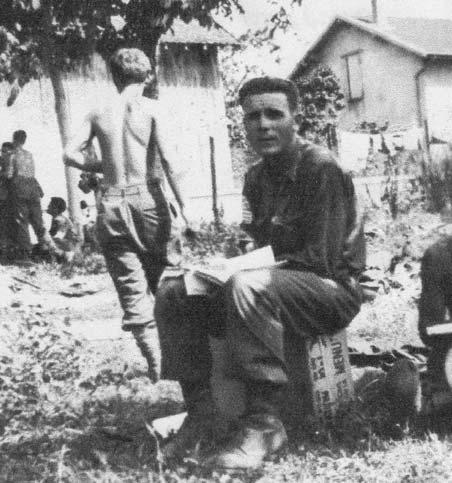
One of Crawford’s duties was to censor mail written by soldiers under his command.
From Venafro, we trudged through the town of Possilli, up a valley and climbed a mountain where we occupied the front line for three days and nights, my first time on the front line. The terrain was rocky and rough and there was some snow on the ground. Needless to say we were not comfortable, but I didn’t suffer from the cold as I had somehow managed to get a pair of tankers’ coveralls, which were lined with GI blanket material. We didn't get into any fighting, but patrols were sent out each night without any results. I was glad to hike down the mountain and go into a rest area at Piedmonte d'Alife. There were USHO shows making their rounds and I got to see one with Humphrey Bogart as the main attraction. After a few days, we were moved back to Bagnoli.
After about three days in the staging area, which was situated in an ancient volcanic crater circled by a high masonry wall, we were becoming a bit bored as we had no scheduled duties and saw no high-ranking officers. Sgt. Conrad Smith and I got to wondering what the country looked like on the other side of the wall. By scanning with our binoculars we could see what appeared to be a break in the wall exactly opposite the entrance gate. We decided to climb the hill and check it out. Another non-com went along. The hill was very steep, but the ground was soft making it easy to get a foothold.

Members of The Church of Jesus Christ of Latter-day Saints meet for service in a field near Salerno on the west coast of southern Italy. The “Mormon” jeep with its beehive, Angel Moroni, and Deseret, became famous among Mormon solders in Italy. J. L. Crawford is on the right end of the front row.

The village of Reipertsweiler in the Alsace area of eastern France near the German border. German soldiers occupy the houses across the stream from where Crawford took this photograph.
The distance must have been about three hundred yards.We made it to the top and found the break we had seen. By helping each other we got over the wall and found ourselves in a vast vineyard sloping off to the east. Not fifty feet from the wall was a man pruning his grape vines who greeted us in English.We told him who we were and he told us he had been in the United States during WWI and had worked at Fort Dix. He invited us to his house, an ancient masonry structure, built on the hillside with a cellar into which a wagon could be driven. Several humongous wooden barrels lined the sides of the cellar. He drew a pitcher of wine from one, explaining that the Germans had taken all of his wine except the one barrel which they graciously left for his use. Then he took us up stairs and had his wife fry up a large pan of potatoes, so with that and her homemade bread we had a feast.
We lost track of time and it was late in the afternoon when we got back over the wall. As we viewed the bottom of the crater, we were flabbergasted as we couldn't see any camp or people. We made it to the bottom in twenty-foot jumps and found one truck loading the last of the tents and bedrolls, ours included. The driver told us they had order to move out with little notice and they were loading onto ships. Within minutes, we were on our way, riding atop a truckload of bed rolls. We were taken to the wharf somewhere in the vicinity of Pozzuoli where I faced an irate Captain Barnes, who threatened to bust me to private and ordered me to get on board and check my men. The ship was a small one, I think it was called an LCI (Landing Craft Infantry).

These children on a snow sleigh in the Alsacian town of Schonberg seem unaffected by the war that brought J. L. Crawford to stay in their house.

Lieutenants Castro and Crawford (right) observe wash day at the community laundry in Glouville in the Alsace region of France.
We spent only one night on board during which time we were told where we were going—Anzio, only thirty-six miles south of Rome. My company was sent to the front line early on the second night on the beachhead. Our position was on the left, next to the shore of the Mediterranean. As we were being oriented by the unit we were relieving, I noticed a stretcher which obviously had a body on it covered by a blanket. I knew that was one of our soldiers, the first casualty of the war I had seen.
I can’t describe the feeling that gave me, but it was one of despair and gloom, which was intensified before morning by several artillery barrages. I had bedded down in a slit trench someone else had dug and it was so shallow I think my nose was above the level of the ground. Fragments of a shell bursting some distance away would pass over me, but a direct hit or even a near miss would mean curtains. I became convinced of the truthfulness of the saying,“There are no atheists in fox holes.” I think I prayed myself to sleep several times. During approximately two and a half months I was on the beachhead, we were moved several times, each time a little farther inland, or to the right.

American soldiers cross the border into Germany.
Following the Anzio experience, time spent in southern Italy was like a summer vacation. It was good to be off K rations for a while. The cooks went to great efforts to find fresh vegetables to satisfy the men’s craving for salads, something they had been denied for so long. Much of my time was spent censoring letters written by members of my platoon. Of course we had to undergo training for amphibious landings and that gave us an inkling of what our next assignment would be.
Some time around the first of August, we were loaded onto ships and spent about a week sitting in the harbor. Then we sailed between the islands of Sardinia and Corsica toward southern France.
What goes on in the mind of an infantryman as he climbs down the rope ladder into a small landing craft? Will I have to swim? Will I get shot in the water or on the beach? Is the beach mined? How far to cover? I remember seeing the splash of only one bullet hitting the water near our boat as I stepped out onto dry sand. We were in a hurry to get off the beach, but were stopped by double-apron barbed wire fence through which we blasted an opening with a bangalore torpedo—a pipe, loaded with TNT, designed to destroy wire obstacles by concussion. The landing was near St. Tropez on the Mediterranean coast of France. It was too easy, but what was ahead? It wasn’t long before men in uniform started appearing with their arms in the air. It turned out they were Polish soldiers who had been pressed into service by the Germans. Besides English, I had five languages spoken in my platoon, including two or three Slavic languages. A squad leader spoke fluent Polish and learned from the Polish prisoners that most of their German leaders had abandoned them and fled north. It was almost evening when a civilian told us there were many Germans waiting to surrender and he would lead us to them. I was detailed to take my platoon and bring them in. Sure enough, there were nearly a hundred officers and men left without transportation. They had piled all their weapons and valuables in one large pile, knowing they would be taken from them sooner or later.
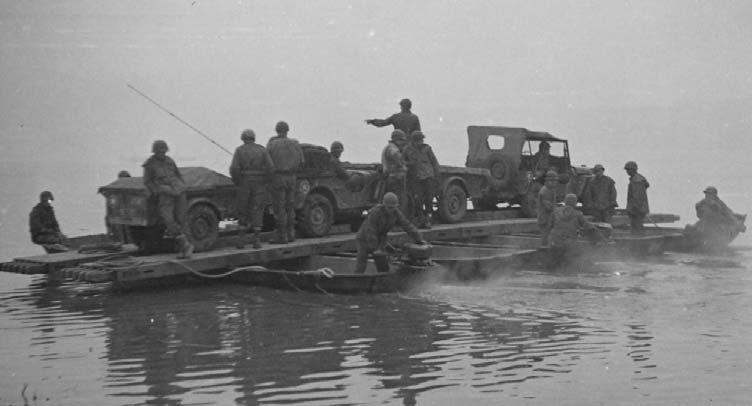
American soldiers cross the Rhine River on this improvised ferry.
We moved fast through France, considering that we still had to fight our way. Several times we made rather long advances riding vehicles, sometimes trucks, but usually tanks or tank destroyers. One time I rode twenty or thirty miles astride the barrel of a 155 mm Long Tom, our largest artillery piece. We had to cross three major rivers—the Durance, Rhone, and Moselle. The Durance was the first and my platoon was in the lead as we pussy-footed across a bridge, not knowing if it was boobytrapped. The bridge was later blown up. I believe the charges were already set when we crossed and I felt very fortunate that we didn’t touch them off.
The Moselle River and the French town of Épinal marked our approach to the Vosges Mountains in northeastern France about the end of September 1944. Near Épinal I spent a night in a WWI trench. It was grass-covered and well-preserved. I was amazed that it had retained its shape all those years. The next day, somewhere between the towns of Épinal and Rambervillers, we got into a battle in heavy woods.

This pontoon bridge across the Danube River provided a secure crossing for personnel and equipment.
Although the Vosges Mountain area of Alsace-Lorraine is a choice part of Europe, we Americans didn’t exactly enjoy our sojourn there during the 1944-45 winter. Our relatively rapid advance up the Rhone Valley ended as the enemy became more determined and the weather, as well as terrain, turned against us. Supply became more of a problem. Rations and ammunition had to be taken to the front daily. Hopefully, hot coffee and a sandwich—or at least a slice of bread—would be a daily treat supplementing our K-rations, but it didn’t always happen. Also, now that the weather had turned colder, sleeping bags were issued but had to be brought up with the rations and they didn’t always make it.The first sleeping bags were lined with GI blanket material. I didn’t see a down-filled bag until after the war when I purchased one from war surplus. I seldom slept in a sleeping bag. My job had become a little easier, however, since somewhere along the line I was made commander of the weapons platoon.The weapons platoon consists of three machine gun squads and two mortar squads. The machine guns are the air-cooled variety. One man could carry the gun while another carried the mount. The mortars were 60 mm, light enough for one man to carry the barrel with the attached legs, while another man carried the base.When the company was in action a machine gun squad would be attached to each rifle platoon, while the mortars stayed in the rear with only an observer at the front. Although I frequently acted as observer to direct mortar fire, it beat carrying a rifle on the front line. Communications between observer and mortars was a problem. Someone had to carry a reel of wire and a sound-powered telephone, and since the wire was frequently cut by mortar or artillery fire, finding the break and patching it was a never-ending headache.

Columns of German prisoners were common scenes near the end of the war.
By early December we had fought our way almost to the German border.The regiment occupied several Alsatian towns while it took on replacements and reorganized. My company was billeted in the town of Schonberg where our company headquarters was in the living room of a farm house. After about a week at Schonberg we were moved to the picturesque town of Reipertsweiler to relieve the 180th Regiment.You could say this was a case of “détente” as we occupied half the town while the enemy occupied the other half, the town being divided by a meadow. We just sat and watched without shooting at each other—well, not very much anyhow. Patrols were sent out a few times. I climbed to the top of a small church that had, instead of a steeple, a very steep-roofed small room which may have served as a belfry. I took a few pictures through a small window, but I didn’t stay there long since I could have been mistaken for a sniper.
In February 1945, I was given the job of Battalion Transportation Officer and on March 15, 1945, we launched the drive that would take us across the German border and on to the Rhine River, which we crossed on March 26th, and moved on to lay siege to the city of Aschaffenburg, which fell to our troops on April 9th. From Aschaffenburg we continued in a northeasterly direction for fifty or sixty miles at a rather fast pace, to about the geographical center of Germany. From there they pointed us south toward Nuremberg and Munich.
It was on the afternoon of April 29th that I arrived at Dachau. I stopped near a line of railroad cars not knowing what they contained until someone told me. Then I had to take a look for myself. I climbed onto the linkage between two cars and peered inside a car. Then I had to go to other cars where I saw more of the same gruesome scenes, dead, emaciated human bodies, dozens of them. I had my 35 mm camera with me and took pictures of contents of five or six cars. No one stopped me so I kept going until I came to the notorious crematory furnaces. They were cold. Nearby were two or three large rooms with dead bodies stacked shoulder high. I thought the rooms must be gas chambers. There must have been hundreds, maybe thousands, of bodies. I tried to take pictures, but it was too dark. I saw a line of guards our men had executed and took a picture of that.
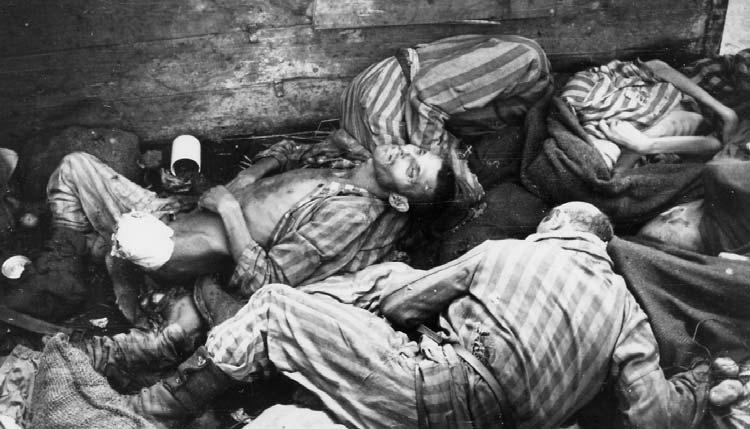
The dead in the concentration camp at Dachau were a disturbing encounter for Crawford and other Americans at the end of the war.
I don’t recall spending a night between Dachau and Munich, but I must have done. Several outfits vied for the honor of being first into Munich and it isn’t known who the winner was.Two of those outfits were the 42nd and 45th Divisions and there was one armored division. All could have entered simultaneously since they all entered in different places. It was evening when my column got into the outskirts of the city and we set up a motor pool. There was quite a celebration as many of our old buddies who had been “guests” of the Germans rejoined us. When rations were issued that evening there was a chorus of “White Bread” as those boys dived onto it like turkeys on grasshoppers. Of course, they hadn’t seen such food in months.
I was never sure just what day was Victory Day in Europe.There was no celebrating that I can remember. I suppose most of us felt the war had been over for a week or more by the time it became official. Anyhow, it seems that May 7, 1945, is considered V-E Day, but all I remember is that I was somewhere in Munich.We were all counting up our “points” to determine if we were eligible to be discharged. I recall that I had eighty-five points, just barely what I needed to get me out.The only problem was that there were so many with more points. We were aware the war was going on in the Pacific and were fairly sure our Division would be sent there.
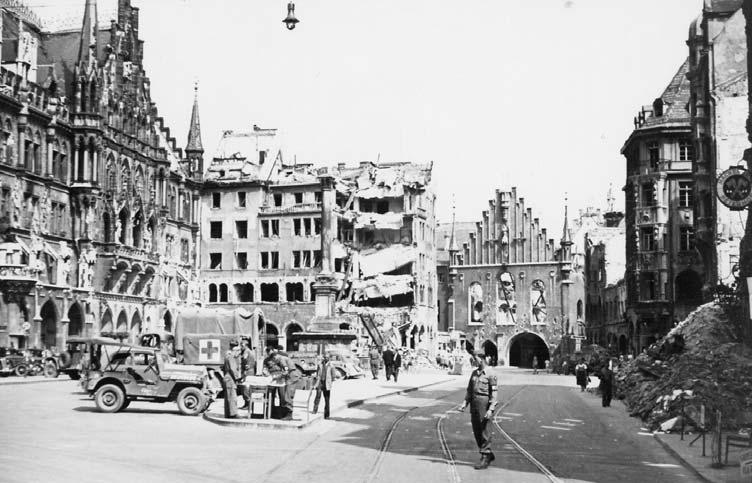
The war damage around the City Hall in Munich is clearly visible in this photograph.

J. L. Crawford was part of the occupation force sent into the beautiful mountains of southern Germany and Austria after the war.
For a short time I was stationed in a small town on the mountainside above the city of Innsbruck, Austria. It was such a beautiful place, I could have settled down and remained there. If there is a more beautiful place on earth than Southern Germany, Bavaria, Austria, Tyrol and Switzerland, I don’t need to see it.
My turn to head for home came in September. We left Germany and crossed much of France by train. The tons of trash we saw deposited in the several railroad stations we went through was evidence that many American soldiers had preceded us. K-ration boxes and other wrappers must have been ankle deep along the tracks. The last leg Homeward bound soldiers on board of our land trip was by truck and mostly at the USS Lejeune. night. We were dumped at Camp Lucky Strike near the port of Le Havre where we had breakfast and lunch before embarking on USS Lejeune. That ship had been a tender of the Graf Spee. I believe it was eight days to the Statue of Liberty.

Homeward bound soldiers on board the USS Lejeune
In going ashore we walked a long way between huge stacks of crates holding half pint cartons of milk. We were invited to help ourselves as we walked along. Some fellows drank three or four, but I have never cared for milk unless I have a slice of bread or piece of pie, so I passed it up. We were allowed one telephone call to home, but there was only one phone in Springdale at the time, so I couldn’t take advantage of that perk. I went into New York City with a group of friends and didn’t do anything except walk around and look. The next day I was on the train and on my way to Fort Douglas.
I was discharged on September 28, 1945, and took the bus to Parowan. I worked in a garage there for a month or two and got back into school at BYU for the winter quarter 1946 on the GI Bill.

